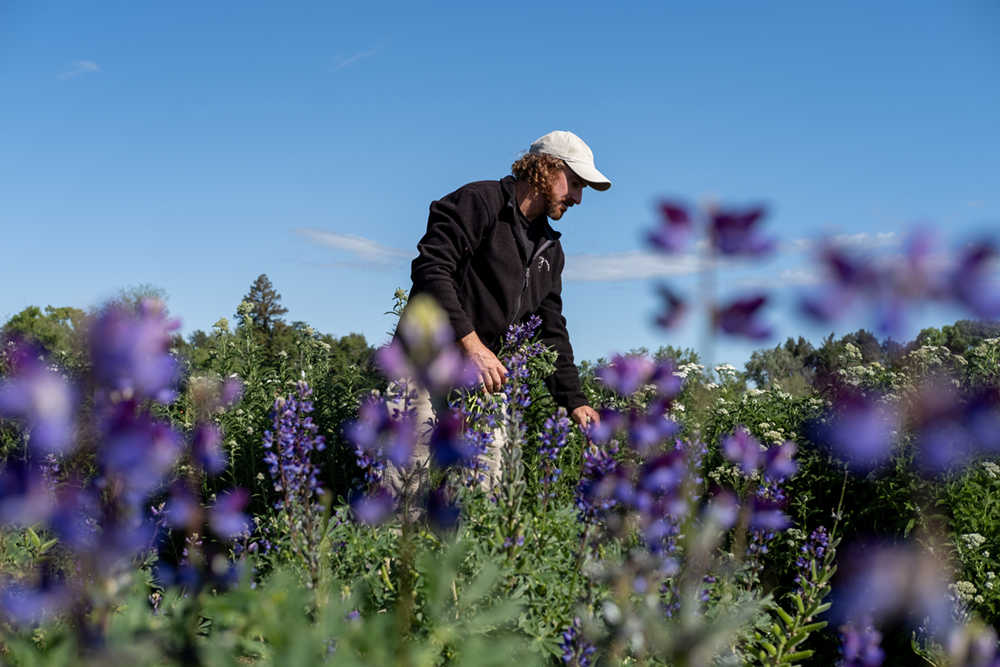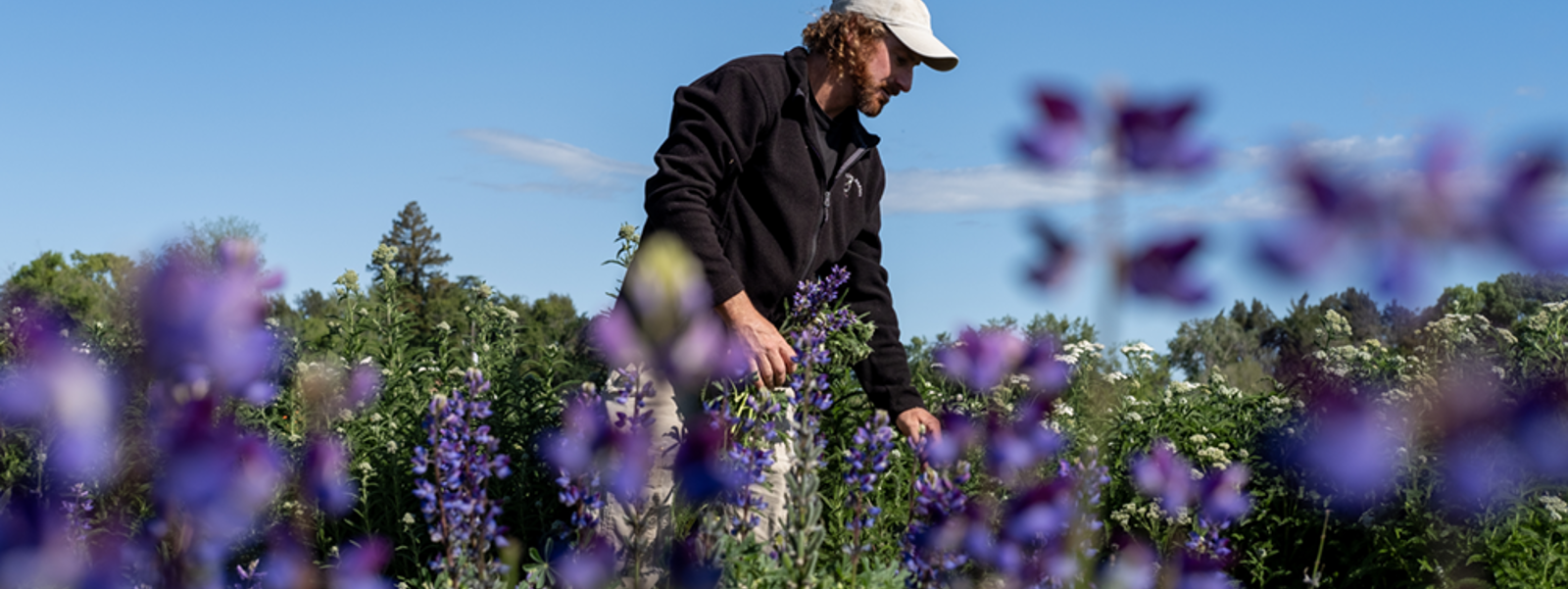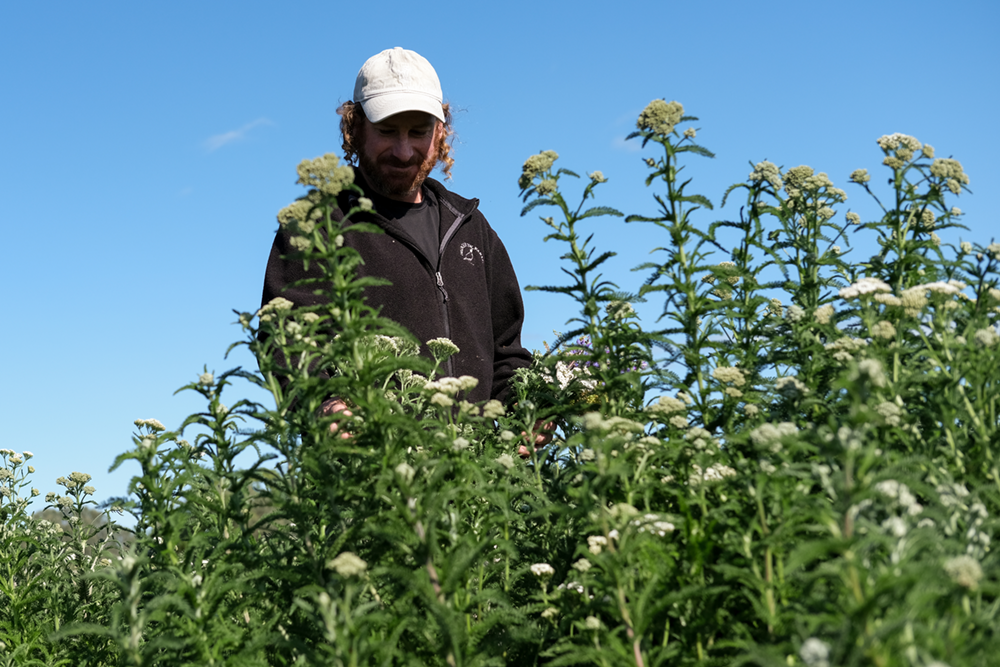Pollinators drive home garden selections

Jeff Quiter, farm manager at Hedgerow Farms in Yolo County, walks between rows of lupine and yarrow that the farm grows for seed for use in home gardens and land restoration projects. Farmers and seed companies report rising demand for wildflowers and other plants that support pollinators.
Photo/Caleb Hampton


Photo/Caleb Hampton
By Caleb Hampton
With plant nurseries germinating seeds for springtime garden transplants, producers and seed companies report steady supply and demand after recovering from a pandemic-time gardening boom that depleted seed inventory for some varieties.
During the pandemic, “We all got a lot more customers really fast, and there were seed shortages because no one was prepared for it,” said Renee Shepherd, founder of Renee’s Garden, a garden seed company based in Santa Cruz County. “I would say that that is behind us now, and most mail-order packet companies are much more well stocked.”
Steve Wiley, general manager and chief operating officer at American Takii, a Monterey County subsidiary of a Japanese seed company that serves commercial agriculture and home gardeners, said the popularity of gardening during the pandemic helped the company compensate for a dip in sales to commercial growers.
“Now it has shifted back to more of the commercial growers, but the home garden market does remain quite strong,” Wiley said.
Seed producers and suppliers said many of the people who started gardening within the past few years stuck with the hobby after COVID-related stay-at-home orders were lifted.
“We haven’t seemed to have lost a lot of the customers who we gained during the pandemic,” Shepherd said. “It’s just that the rapid growth rate has diminished to what it is in most years.”
This year, many home gardeners are opting to grow plants that bring environmental benefits such as water conservation or pollinator habitat. While vegetables such as tomatoes and cucumbers remain popular, suppliers said they have seen rising demand for flowers.
“Home gardeners are looking at how they can make their gardens more welcoming to both bees and other pollinating insects and birds, and just generally support wildlife,” said Shepherd, who is a director of the Home Garden Seed Association. “We’re seeing flowers make a little bit of a comeback.”
Wiley said he has also observed increased demand for flowers as gardeners gain more appreciation for the role pollinators play in cultivating a productive garden.
“If you don’t have a few bees visiting your flowers, your melons won’t get pollinated and may not make a crop,” he said. “They’re good for the overall environment, and they provide benefits for other plant species, be they decorative or food crops.”
Finding habitat in residential gardens can also make a difference for California’s roughly 1,600 bee species, many of which are threatened or endangered.
“The good news is that we don’t need to create huge national parks to protect these pollinators,” said Julia Michaels, restoration ecologist at Hedgerow Farms, a native seed farm in Yolo County. “You can really take a bite out of this problem just in your own garden.”
For decades, Hedgerow Farms has specialized in growing large quantities of native grass and wildflower seed for land restoration projects. Last year, the farm began selling retail seed for home gardens. With its focus on habitat restoration, the farm produces a unique range of seeds that meet the demands of a growing number of gardeners.
“We were blown away by the amount of interest” in seeds of native grasses and wildflowers, Michaels said, which Hedgerow Farms sells through a partnership with the online seed packet company Nature’s Seed. She said the farm’s success in the home garden sector could inform future cropping decisions as gardeners drive demand for certain species.
Recent favorites among home gardeners have been wildflowers such as lupine, clarkias and California hibiscus.
Funding offered by some cities to incentivize homeowners to replace traditional grass lawns with drought-resistant plants has helped drive sales, Michaels said, especially of species such as slender sedge, a native grass favored for landscaping.
While it might once have been fashionable to have a gorgeous lawn, Michaels said “the new status symbol” may be to have a drought-resistant garden with pollinator habitat.
“People are thinking about what they can contribute to the world through their individual gardens and feeling more empowered to make a difference,” she said.
California seed producers such as Hedgerow Farms and American Takii, which grows its own vegetables for seed in the Salinas Valley, reported favorable growing conditions so far this year.
Due to increased production costs, “we’ve seen a little bit of a contraction of acreage of most crops,” Wiley of American Takii said. Like many seed companies, Takii breeds vegetables and flowers for seed in North America, Europe and Asia.
When it comes to vegetables, gardeners continue to prefer varieties with short growing seasons such as cabbage, broccoli and cauliflower, all of which reach maturity within 90 days, Wiley said.
“We have very good onion seeds,” he said, “but we don’t sell a lot into the home garden market because the typical onion has to be in the ground almost half a year.”
Shepherd of Renee’s Garden noted a recent preference for vegetables such as lettuce, cucumbers and dwarf tomatoes that can be grown in small containers on a deck or patio. “People want to find tomatoes that don’t grow 6 feet,” she said.
Home gardening may be a small niche within agriculture, but when it comes to consumer preferences, “I think we are a good bellwether of what’s going on,” Shepherd said. “Home gardeners are people who go to the supermarket, so you want to keep track of what is popular and what people are looking for.”
Judging by this year’s seed orders, she said, grocery stores may be wise to stock up on chili peppers and Asian vegetables such as gai lan and bok choy.
“International trends are strong,” Shepherd said. “In other words, bringing the world into your garden.”
(Caleb Hampton is an assistant editor of Ag Alert. He may be contacted at champton@cfbf.com.)




